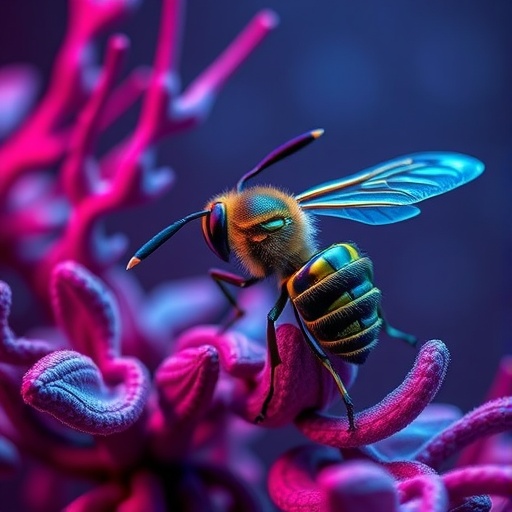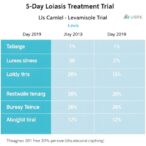
In a groundbreaking study published in Nature Plants, a multinational team of plant biologists has unveiled a novel and highly specific molecular pathway that elevates plant defense responses against herbivorous attackers. The research spearheaded by Li, R., Wang, X., Haj Ahmad, F., and collaborators reveals that the protein Poltergeist-Like 2 (PLL2) acts as a pivotal regulator in mediating herbivore-induced defense, distinctly separating the systemin signaling mechanism from other immune pathways. This fresh insight marks a significant leap in our understanding of plant immune complexity and opens avenues for the development of next-generation crop protection strategies.
Plants have long been known to deploy a sophisticated array of defensive mechanisms to counteract herbivory, ranging from physical barriers to chemical warfare. Among the molecular orchestrators of these responses, systemin—a small peptide hormone—has been established as a critical messenger that amplifies wound and herbivore-associated injury signals. However, the precise molecular intermediaries and signaling cascades that define systemin-driven defenses have remained elusive until this novel discovery of PLL2’s indispensable role.
Historically, the systemin pathway has been primarily characterized by its ability to induce jasmonic acid (JA)-mediated defenses, triggering the synthesis of protease inhibitors and other anti-herbivore metabolites. Yet the delineation between systemin and other pathogen-related immune responses, such as those mediated by salicylic acid (SA), was poorly defined. The present study bridges this gap by elucidating that PLL2-dependent activation specifically tailors the plant’s response to herbivore stress, functioning independently from canonical immune signaling routes.
.adsslot_pjGsbc27kS{ width:728px !important; height:90px !important; }
@media (max-width:1199px) { .adsslot_pjGsbc27kS{ width:468px !important; height:60px !important; } }
@media (max-width:767px) { .adsslot_pjGsbc27kS{ width:320px !important; height:50px !important; } }
ADVERTISEMENT
At the core of this research lies an integrative approach combining genetic, biochemical, and molecular analyses across multiple plant species including model organisms and economically important crops. The investigators employed loss-of-function mutants and overexpression lines to dissect PLL2’s functional relevance. The data demonstrate that PLL2 is indispensable for the effective transduction of systemin signals, facilitating the rapid mobilization of defensive metabolites exclusively in response to insect herbivory rather than microbial challenge or abiotic stress.
Phosphorylation assays further reveal that PLL2 exerts its function through a finely tuned kinase activity, modulating downstream substrates involved in cellular signaling networks. The authors postulate that PLL2 acts as a molecular switch that distinguishes between diverse environmental cues, ensuring the plant mounts a tailored defense without unnecessary energy expenditure. Such specificity is of critical ecological importance, preventing cross-talk interference that could compromise overall plant fitness.
This study deepens our understanding of the sophisticated molecular dialog plants maintain with their environment. The specificity of PLL2 in channeling systemin signals sheds light on how plants integrate multiple stress signals and prioritize responses. It is now clear that activation of PLL2 constitutes a hallmark of herbivore-specific immunity, setting it apart mechanistically from SA-dependent pathogen responses and other generalized defense pathways.
Importantly, the authors discovered that PLL2 localizes predominantly at the plasma membrane, where it presumably interacts with systemin receptors and other signaling components. This spatial distribution primes it for rapid engagement following herbivore attack, contributing to the speed and efficacy of the defense response. The membrane association also suggests potential cross-regulation with membrane-bound pattern recognition receptors (PRRs), hinting at a complex signaling network yet to be fully elucidated.
The implications of this research extend far beyond academic curiosity. By pinpointing PLL2 as a crucial node in herbivore defense signaling, this study provides a promising molecular target for genetic engineering and breeding programs aimed at enhancing crop resistance. With worldwide agriculture under continuous threat from insect pests and the limitations of chemical pesticides mounting, harnessing endogenous plant defense mechanisms offers an eco-friendly and sustainable alternative.
Moreover, this discovery invites a reevaluation of the traditional paradigms of plant immunity, highlighting a layer of selective responsiveness finely attuned to the nature of the external threat. The systemin-PLL2 axis exemplifies the evolutionary sophistication of plant defense regulation, where precise molecular discrimination enables adaptation to a wide spectrum of biotic stresses without collateral damage to growth and development.
Through transcriptomic and proteomic analyses, the researchers also mapped the downstream cascade triggered by PLL2 activation. They identified a suite of transcription factors and secondary metabolite biosynthetic genes uniquely induced upon PLL2 engagement, underscoring the tailored nature of systemin-triggered responses. These findings underscore the importance of context-dependent gene regulatory networks in modulating defense effectiveness.
Interestingly, the study also identified feedback mechanisms that modulate PLL2 expression and activity post-activation, suggesting that plants maintain a homeostatic balance to prevent hyperactivation and associated fitness costs. These regulatory loops could serve as critical targets in fine-tuning defense responses for agricultural applications, balancing resistance with yield stability.
The methodological rigor and interdisciplinary scope of this study set new standards for plant immunity research. Integrating advanced CRISPR gene-editing techniques, real-time live-cell imaging, and comprehensive biochemical assays allowed the team to dissect intricate signaling events with unprecedented resolution. Such technological synergy brings us closer to fully decoding the complex communication networks plants use to thrive amidst relentless environmental challenges.
This pioneering research not only advances fundamental plant biology but also holds the potential to revolutionize strategies in integrated pest management. By leveraging molecular components like PLL2, future crop varieties could be developed to inherently withstand herbivore pressure, reducing reliance on synthetic chemicals and mitigating environmental damage associated with conventional pest control.
As the global population continues to rise and climate change exacerbates agricultural vulnerabilities, innovations such as the PLL2-mediated herbivore defense highlight the critical role of cutting-edge science in ensuring food security. Understanding and manipulating plant innate immunity represents a promising frontier in sustainable agriculture, where nature’s own mechanisms inspire the next generation of crop protection technologies.
The discovery of PLL2’s unique position in systemin signaling exemplifies the elegant intricacy of plant immune systems, reflecting eons of evolution tailored toward survival in a dynamic biological arena. As further research builds upon these findings, the full spectrum of PLL2’s roles across species and contexts may unveil additional layers of immune modulation, potentially offering broader implications across plant biology.
Ultimately, the insights gained from this study pave the way not only for academic inquiry but also for real-world applications. The ability to precisely activate herbivore defenses via targeted manipulation of PLL2 and its signaling network might herald a new era where crop resilience is achieved through sustainable, molecularly-informed approaches, harmonizing agricultural productivity with environmental stewardship.
Subject of Research: The investigation centers on the molecular signaling mechanisms underlying plant defense against herbivorous insects, focusing on the role of Poltergeist-Like 2 (PLL2) in systemin-mediated immune responses.
Article Title: Poltergeist-Like 2 (PLL2)-dependent activation of herbivore defence distinguishes systemin from other immune signalling pathways
Article References:
Li, R., Wang, X., Haj Ahmad, F. et al. Poltergeist-Like 2 (PLL2)-dependent activation of herbivore defence distinguishes systemin from other immune signalling pathways. Nat. Plants (2025). https://doi.org/10.1038/s41477-025-02040-7
Image Credits: AI Generated
Tags: chemical defenses against herbivorycrop protection strategiesherbivore resistance in cropsherbivore-induced defense responsesjasmonic acid-mediated defensesmolecular pathways in plantsnovel plant biology researchPlant defense mechanismsplant immune complexityPoltergeist-Like 2 proteinsystemin signaling pathway



